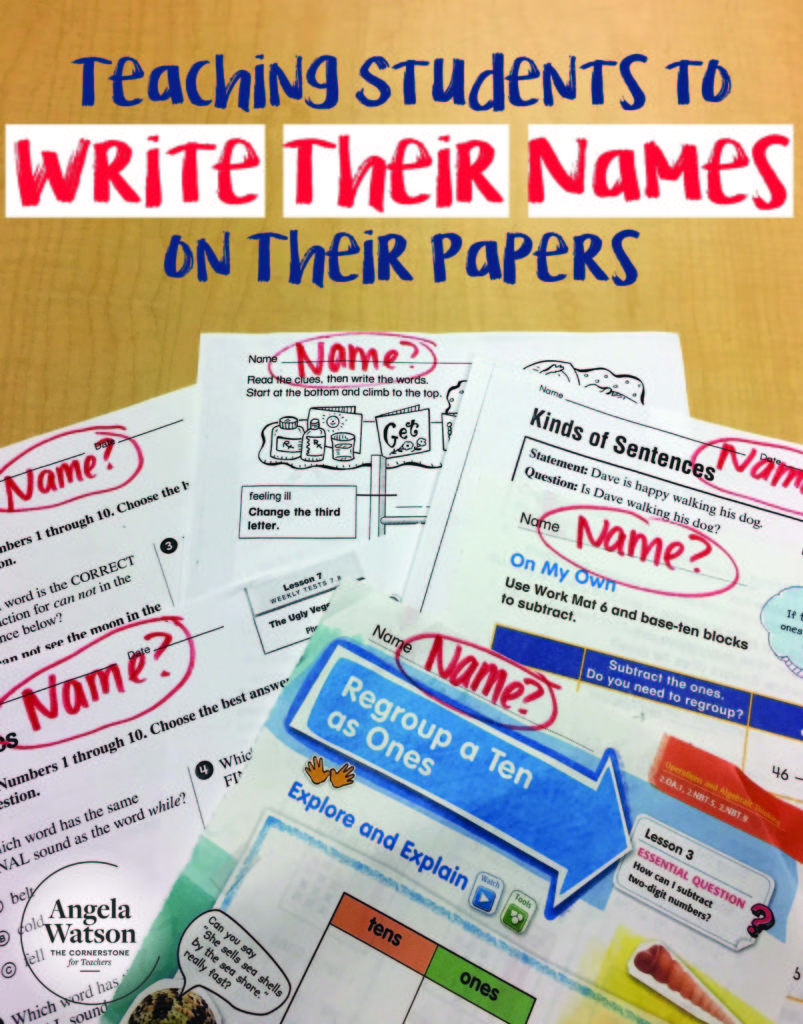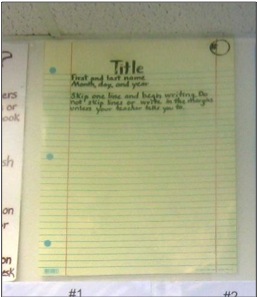How do you teach kids to write their names on their papers? What should you do when they forget? Should students be punished for not putting the heading on their assignments? This page has tips and tricks for avoiding the no-name paper problem!

Is it necessary to have all kids head their papers the same way?
It depends on your preferences. Some teachers don’t pay much attention to this issue: as long as kids have their name on the paper some place, they’re okay with it. Other teachers (especially those who teach multiple classes and/or multiple subjects) find it much easier to manage the grading process if every paper is perfectly clear about what the assignment was, who wrote it, and when they wrote it. Personally, I find that teaching kids to head their papers in a certain way contributes to an orderly and well-run classroom. But if you’ve got more important things to worry about than paper headings, that’s perfectly fine!
Some years, I brainstormed with my kids what the heading should look
like. I asked, “Is there anything that absolutely must be put on every paper you turn in? What things are needed? Why? Should we all agree to put those things in the same place on every paper every time? Is there an advantage to that? What?” Every time I did this, my students wanted uniformity in their headings, primarily because they wanted to make sure they got credit for everything they turned in, and so they would know what to do with papers they found on the floor or stuffed in their desks (“It will be easier to tell who forgot to turn their paper in and what stack of assignments it goes in!”)
Teaching the procedure

I view kids neglecting to put their names on their papers as a procedural issue, not a behavioral issue, and kids who don’t follow procedures need practice, not punishment. Being pro-active and teaching kids your expectations is the key to for any procedure or routine.
So, at the beginning of the year, I do a LOT of modeling and practicing with proper paper headings so kids know exactly what’s expected…and just as importantly, why it’s expected. The exact process I use for this is spelled out in complete detail in The Cornerstone book.
Usually for the first two weeks of school, I have kids highlight each element of the heading after they’ve written it. Because highlighters are so fun for third graders to use, they want to highlight as much as possible and don’t want to leave out a single element!
I also like to teach the kids that when papers are passed in, one person at each team is responsible for making sure all students in the group have the correct heading. That way, if a student forgets, someone at the table reminds him or her before I even see the assignment. Since every student on the team has a specific role in distributing supplies and turning work in, making sure that every student wrote their name on their paper becomes a team effort and kids who are more forgetful have extra support. See the page on passing in and collecting papers for more info on this managing this.
Why is it important to put the heading on your paper?
As the year progresses, there almost always comes a time when I notice there are multiple students not putting their names on their papers. That’s when I have a quick conversation with the kids about it: “I’ve got a bunch of papers here with no name on them. Let’s see…1,2,3…6 papers! What do you think will happen now with these papers? Exactly. Now I’ve got to figure out who they belong to. What if I make a mistake and accidently give the wrong grade to the wrong person? Imagine you earned an A but I thought your paper was someone else’s and you got a D? That would be terrible, right? Why else is it important to remember to put our names on papers? What can we do as a class to help each remember to do that?”
Giving positive reinforcement
With my third graders, regular reminders about writing their names on their papers were often needed. So, as a positive reinforcement throughout the year, I’d often stop and thank the kids for remembering to head their papers. If I graded an assignment that had every single paper with the correct heading, I’d announce to the class, “Can you believe every single person remembered the procedure for heading papers this time? You should be so impressed with yourselves! We didn’t have to wait a single moment for anyone to figure out which paper was theirs, and we can move right on to the next activity. Wait until I tell the other teachers at recess how responsible you all have been.”
Then when we went outside, I’d make a big show of recounting the kids’ success to my grade level team before releasing the class to go play. Bragging about my fantastic kids to the other staff members was a great motivator and reward for my students (especially when my co-workers oohed and ahhed over them, too!) and I tried to do it as often as possible with all sorts of different accomplishments.
Also, I would occasionally hand out beads to students who remembered to put their names on their papers. Just randomly when I noticed we had a few minutes before lunch, I’d gather up the papers I just collected and say, “Wow, look at all the people who remembered to use the correct heading on their papers! I’m so impressed, I think these people have earned a bead! If I call your name, come on up and choose a bead.” Afterward, I’d say, “Anyone who didn’t have your name called…you must have forgotten to put your name on your paper this time. That’s okay. When we line up for lunch, you can come over and fix it! And you never know when I’m going to give beads for this next time! I bet you’ll be ready then!”
Little things like this communicate to the class that the expectation is important and valued because it contributes to an effective and efficient learning environment. Far more powerful than punishment, positive reinforcement makes boring tasks like heading a paper more meaningful and rewarding.

Angela Watson
Founder and Writer
Sign up to get new Truth for Teachers articles in your inbox
Discussion
OR

Join our
community
of educators
If you are a teacher who is interested in contributing to the Truth for Teachers website, please click here for more information.
















Hi Angela,
I am currently running a learning center in Guam out of my home for ages 3-5. I have my B.A. in Early Childhood Education and I am looking for some good sites with lesson plans and professional development for Early Childhood teachers. I need to stay on top of early childhood educational trends, ideas etc.. because I am on my own so I need to do my own development.
Best Regards,
Buffi Burk
http://christinepinto.com/gafe-4-littles-pln/
My son is in 6th grade and has forgotten a few times this year to put his name on his assignment when handing in. Last time his teacher made him write 50x “i wii not forget to put my name on my paper”. Today my son told me he forgot his name again and now he has to write that sentence 75x. Just wondering your thoughts about this. As a side note my son has Aspergers and be a bit forgetful at times.
My personal opinion…and it’s just that, an opinion…is that writing sentences is a pretty outdated teaching practice. It would probably be more effective if the teacher put more systems in place to help set your son up for success (buddy up with a partner before turning in work to ensure the heading is correct, for example.) Maybe you could suggest to your son that he initiate this practice himself.
This practice went out in 1970. We learned from our mistakes that this does not motivate students.
Angela–
Your writing voice sounds as though you are still teaching. Is this actually the case?
Karen
I’m an instructional coach now. Any present tense references to what I do with kids refers to model lessons I conduct in classrooms when I’m coaching.
Greetings,
What if an eight grade student is not writing his/her name on things?
I realize that students should have this skill mastered by eight grade but this one doesn’t.
It is not an occasional mistake or simple forgetfulness. It seems to occur nearly every time even after the student has been reminded in a pleasant tone. I will add that this student also has difficulty with attendance and submitting things on time. The parents also don’t seem to place much importance on these things. Communication with the parents usually results with them expressing their opinion that the teachers of the child need to teach him/her differently.
Thank you